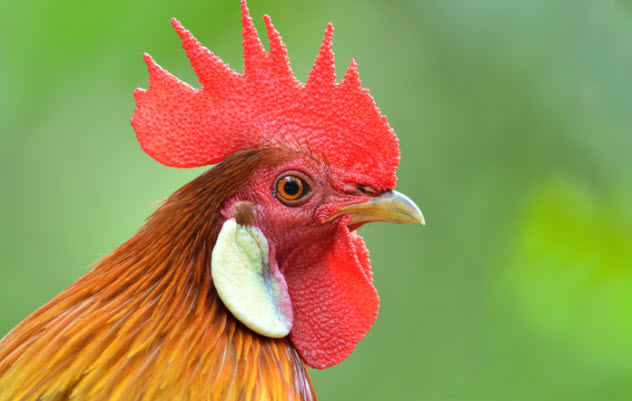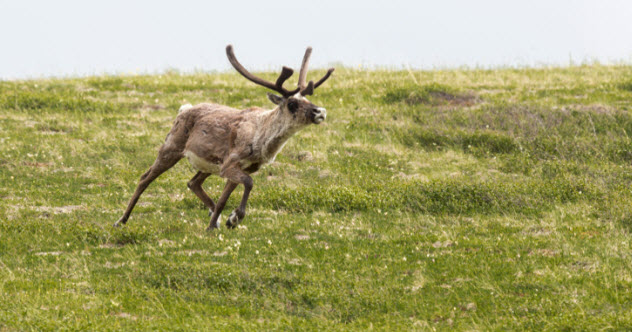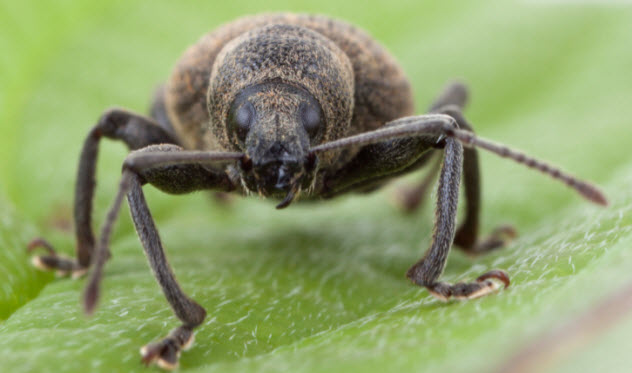 Weird Stuff
Weird Stuff  Weird Stuff
Weird Stuff  History
History 10 Legends Whose Last Moments Undid Their Glory
 Health
Health 10 Futuristic Ideas to Treat Common Medical Problems
 Weird Stuff
Weird Stuff Ten Surreal Attempts to Reverse Baldness
 Facts
Facts 10 U.S. Government Contingency Plans for the Unthinkable
 History
History 10 Weird Distractions from the Great Depression
 Movies and TV
Movies and TV 10 Fictional Kings Who Go from Good to Bad
 Food
Food The Fantastic Chemistry Behind Why 10 Popular Foods Taste So Good
 Technology
Technology 10 Futuristic Fungal Technologies
 History
History 10 Not-so-Spooky Events That Also Happened on October 31
 Weird Stuff
Weird Stuff 10 Things So Rare They’ve Only Been Found Once
 History
History 10 Legends Whose Last Moments Undid Their Glory
 Health
Health 10 Futuristic Ideas to Treat Common Medical Problems
Who's Behind Listverse?

Jamie Frater
Head Editor
Jamie founded Listverse due to an insatiable desire to share fascinating, obscure, and bizarre facts. He has been a guest speaker on numerous national radio and television stations and is a five time published author.
More About Us Weird Stuff
Weird Stuff Ten Surreal Attempts to Reverse Baldness
 Facts
Facts 10 U.S. Government Contingency Plans for the Unthinkable
 History
History 10 Weird Distractions from the Great Depression
 Movies and TV
Movies and TV 10 Fictional Kings Who Go from Good to Bad
 Food
Food The Fantastic Chemistry Behind Why 10 Popular Foods Taste So Good
 Technology
Technology 10 Futuristic Fungal Technologies
 History
History 10 Not-so-Spooky Events That Also Happened on October 31
10 Of The Strangest Crimes Involving Animals
Sometimes, animals become involved in human crimes through no fault of their own. They may be used as a threat or a weapon. They may even become the object of the crime, as in cases where animals are stolen. At other times, they may actually help police to solve crimes. Following in the wake of this amazing list, here are 10 more bizarre crimes involving animals.
10 The Mafia Menagerie

Some Mafia bosses in Italy raised their tyranny to “Bond villain” status by threatening people with exotic animals. One mafioso kept a crocodile on his terrace and fed it live rabbits in full view of his neighbors. Local business owners were ordered to pay protection money or be fed to the crocodile the same way.
The reptile was about 2 meters (6 ft) long and weighed about 40 kilograms (90 lb). It was confiscated in a police raid and sent to a rehabilitation center while its owner was charged with illegal animal possession.
In Villa Literno, mafia thugs smashed the back window of a 58-year-old businessman’s car and dropped a 3-meter (10 ft) boa constrictor inside. “It was a clear message of intimidation,” said a senior officer of Italy’s environmental police in an interview with Corriere della Sera.
Mob-connected drug dealers also used a white python to guard cocaine supplies and a somewhat less intimidating parrot to threaten people and ask what quantity of drugs they required. A fully grown Siberian tiger, kept in a cage on an estate to impress friends and scare enemies, was confiscated from another Mafia boss and transferred to an animal park in Bologna.
9 The Pet Parrot And Indian Police
Suresh Sakharkar of India allegedly spent two years training his pet parrot, Hariyal, to insult and swear at his stepmother. Hariyal offended the woman every time she walked past Sakharkar’s home. When the stepmother complained to local police that the parrot was “hurling obscenities” at her, all three parties were detained. “We watched the parrot carefully but it did not utter a word at the police station after being confronted by the complainant,” a police official told The Independent.
Though Hariyal resisted interrogation and was ultimately unhelpful, another Indian parrot actually assisted police in a murder investigation with no leads. A woman and her pet dog had been killed, and her widowed husband became discouraged when police admitted that the case had lost momentum.
However, the family parrot had silently witnessed the crime. He began behaving strangely whenever the dead woman’s nephew entered the home or when the nephew’s name was mentioned in conversation. The suspicious widower soon told the police about it. When the police began looking into the nephew’s possible involvement, the man broke down and confessed. Coincidentally, “Hercule the parrot” was only a few letters off in sharing his name with fictional supersleuth Hercule Poirot.
8 The Poison Frog Plot

Awaiting trial for allegedly defrauding investors of £6 million, Hans Paulssen was remanded to custody at London’s Pentonville Prison. He was already facing a hefty sentence, but his situation was made worse by codefendant Jennifer Newmarch’s plan to implicate him as the mastermind behind the crime.
So he came up with his own plan. He asked a fellow inmate for help in having Newmarch killed. However, this person immediately told authorities of Paulssen’s murderous intention.
Posing as a criminal underworld contact, an undercover policeman (who had been given the uninspiring code name “David”) was sent to meet with Paulssen and quickly discovered his plan, which the prosecutor would later describe as being like “a murder plot from some B movie of the 1940s.”
Paulssen asked David if he had heard of a special type of Amazonian frog—one whose poison could cause a human heart attack without leaving any trace of the substance in a person’s system. An expert at Paulssen’s trial confirmed that certain species of the poison dart frog secrete a poison so highly toxic to humans that it can kill in miniscule amounts, making it untraceable. Paulssen had hoped to use one of these frogs to kill Newmarch.
Besides being convicted of fraud, he was sentenced to an additional two and a half years for soliciting murder.
7 Revenge By Rattlesnake

Two Colorado men were charged with conspiracy to commit murder after hatching a crazy plot to kill Matthew Sowash, against whom they held a grudge. They planned to construct a wooden box that housed deadly rattlesnakes and then trap Sowash’s feet and lower legs inside.
The two also planned to kidnap Sowash’s children to extort ransom, supposedly to compensate one of the men for a large monetary debt owed to him by Sowash. They began by sending threatening emails to Sowash, who promptly ratted them out to the FBI.
In a separate case, a rattlesnake was once used in Arizona to exact revenge on a supposed snitch. Nathaniel Harrison broke into the victim’s house, accused him of ratting out his friend to police (which resulted in jail time for the friend), and threatened to kill the man as revenge.
Then Harrison broke a board over the man’s head and tried to get a rattlesnake to bite him. Harrison’s plan could have backfired because he used his bare hands to handle the venomous reptile. Luckily, the snake refused to cooperate, and Harrison was soon arrested on a host of charges. The snake was released back into the wild.
It was later revealed that Harrison had an extensive criminal history and possible mental problems. Apparently, he liked to use animals to exact revenge. He had previously tried to throw a hornets’ nest inside the home of a fellow resident at the caravan park where he frequently stayed when not incarcerated.
6 The Heretical Rooster Of Basel

It was common practice in medieval times to try animals in court for their “crimes.” Often, the animals were literally brought in front of a judge. Sometimes, they were even dressed in human clothing. Although they could receive mercy, these accused animals were more likely to become convenient targets for human cruelty.
The idea for animal prosecution and punishment was supposedly based on scripture found in Exodus 21. There, it states that if an ox kills a human being, the creature is guilty in the eyes of God and should be put to death.
When people questioned if animals should be condemned for their crimes, theologians clarified the issue with arguments based on scripture. This time, the text came from Genesis, where God grants dominion over animals to humankind.
So if an animal revolted against this hierarchy, it was guilty of inverting a divine decree. The theologians also said that ignorance of sin was no defense because the animal was witlessly serving the aims of Satan by perverting God’s order of things.
This theme of the Devil’s inversion of things became a serious concern throughout the Middle Ages, which is how a rooster in the Swiss town of Basel found himself on trial in 1474. His crime: He had reportedly laid an egg.
In those times, if an egg didn’t have a yolk and wouldn’t hatch, it was believed to have been laid by a cock. This was a sign that Satan was gaining in his ongoing struggle to overturn the decrees of the Supreme Being. Worse yet, if a cock’s egg actually hatched, it supposedly could produce a demonic reptile known as a “basilisk” (aka a “cockatrice“).
A basilisk could kill you with its stare and breath alone. According to Pliny the Elder, the only thing that could kill a basilisk was the stink of a venomous weasel. Cock eggs were also believed to attract sorcerers. Obviously, no one wanted Basel to become known for its basilisks, black magicians, and preventive weasel pong, so the rooster was promptly tried as a demon or sorcerer in disguise and burned at the stake.
5 Gorgeous Camel Rustling

In 2010, thieves attached ropes to five valuable camels on a Saudi Arabian farm and pulled the bewildered beasts through the gates into a getaway vehicle. These abducted camels were particularly valuable because they had previously won beauty contests. In Saudi Arabia, camels are prized for their beauty, especially if they have pretty eyes, fine cheekbones, and an affectionate nature.
The camels in question were collectively worth a staggering 15 million Saudi riyals, which equates to over $4 million. The daring thieves were caught only a few days later, and the camels were returned.
Some Asian workers staying in Saudi Arabia were also arrested for camel rustling the same year after abducting a camel, beating it to death with iron bars, and feasting on one of its legs. Strangely, two camels were likewise rustled from a farm in Columbia, Missouri, in early March 2015.
4 Siberian Hooliganism

Ethnic minorities in Siberia found they could never fully return to their traditional, self-sufficient ways of life after Soviet communism brought modern infrastructures and systems to the polar region. However, when the administrative regime collapsed, the infrastructures and systems broke down, too. The indigenous peoples were now dependent upon but neglected by the state. Alcoholism and crime rates rose with the loss of economic stability.
In recent times, criminals from indigenous minority groups in Siberia have been outrunning Russian police by employing “getaway reindeer.” Police seem unable to stop the drunken fights, robberies, and acts of hooliganism which are endemic in the region. Modern snowmobiles break down or run out of fuel, stranding officers in the middle of the tundra before suspects can be apprehended. The police have been requesting their own reindeer or camels since 2012.
3 Fish And Slavery
Illegal fishing makes millions for transnational gangs of organized criminals each year. In fact, they sometimes make more money from trading illegally harvested seafood than from trading illegal drugs. If you’re in the US, you may think that the seafood you’re eating has nothing to do with that, but you could be wrong. On a national basis, America only created systems for tracking the origin of seafood products in early 2015. Those systems will begin rolling out over the next few years.
In Eastern Europe, Africa, and Southeast Asia, poverty is a bigger incentive for criminals and corruption. International fishing laws are also much harder to enforce. Filtered through legitimate trading, seafood eaten around the world may have originated from countries where a human life bizarrely has less value than a consignment of fish.
This is certainly the case in Thailand where fishing boats have been crewed with boys primarily abducted from Cambodian villages. These children are given amphetamines and forced to harvest fish 20 hours a days for months.
In the book Sex Trafficking: Inside the Business of Modern Slavery, Colonel Suchai Chindavanich of an anti-trafficking police unit in Thailand reveals that many of these boys are shot and thrown overboard at the end of the season. Some of the murderous fishing boat captains, finding their industry in crisis as the Western world slowly wakes up, are now turning to human trafficking instead.
2 Vineyard Vandalism By Evil Weevils

In another ridiculous case of animals being tried in a medieval court, weevils in a French provincial town were accused of ruining a vineyard in 1545. The town’s priest intervened, claiming that the weevils had been sent by God to punish the vineyard owners for not paying their tithes promptly. The trial was postponed as the vineyard owners repented, and the priest attempted to exorcise the pests by saying three special masses.
Amazingly, the weevils actually packed their metaphorical tiny weevil suitcases and left town. They disappeared for approximately 40 years, which is spookily biblical. Returning from exile, the weevils started vandalizing vineyards again and were once more brought to trial before a judge.
This time, the townsfolk went as far as gifting the weevils with their own piece of land. The pesky insects were ordered to live there and threatened with excommunication should they ever backslide into their grape-ruining ways. The judge’s final verdict at this months-long trial is sadly unknown because the final pages of the public record were consumed by insects.
1 Lord Lucan And The Dangerously Eccentric Zookeeper
You might think you’ve already heard everything about the Lord Lucan disappearance mystery. But more witnesses have come forward with new evidence. Although Lucan was found guilty in absentia of murdering his daughter’s nanny in 1975, we now have new information about where he went into hiding to spend the rest of his life.
Most people now believe that Lucan was spirited out of the country by his wealthy friend John Aspinall, a renowned eccentric who had owned two wildlife parks before he died in 2000. Over the years, five of his zookeepers had been horribly killed because Aspinall insisted that they interact closely with dangerous animals to bond with them. Aspinall was also sued for negligence when a boy’s arm was ripped off by a chimpanzee at one of his wildlife parks.
However, Aspinall was a keen conservationist. At his wildlife parks, he successfully bred endangered animals, including African gorillas and black rhinos. Aspinall’s African connection might explain why he allegedly helped Lucan escape to that continent and supported Lucan while he lived there in exile.
After Aspinall’s death, his former assistant claimed that she had arranged an African holiday for Lord Lucan’s children so that he could observe them from a distance without revealing his presence. This lends credence to several alleged sightings of Lucan in Africa over the years and the apparent discovery of his wristwatch in a South African pawn shop.
As of mid-October 2015, Lucan’s son, George Bingham, has sought closure by applying to have his father declared “presumed dead” under the UK’s Presumption of Death Act, which became effective in 2014.
HTR Williams was once charged with defacing the side of an elephant in a shameless attempt to promote his novel Jumping Tracks which, incidentally, has a rabbit in it. Those refusing to read the book were mysteriously attacked by highly aggressive clouds of eye-devouring locusts. The elephant never forgot. She suffered great trumpeting nightmares and now consumes three buckets of Valium per day.








